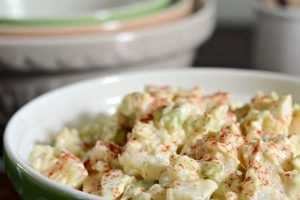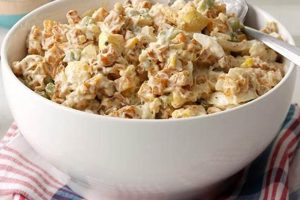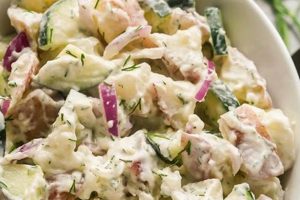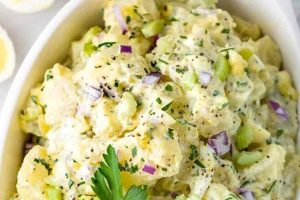Potato salad, a classic picnic and barbecue side dish, finds a refreshing twist with the addition of dill. This vibrant herb lends its bright, slightly tangy, and anise-like flavor to the creamy base, creating a unique culinary experience. Variations range from simple recipes highlighting the dill and potato combination to more complex versions incorporating other fresh herbs, vegetables, and dressings.
The incorporation of fresh dill offers a lighter, more nuanced flavor profile compared to traditional potato salad recipes. This can be particularly appealing during warmer months. Historically, dill has been prized for its culinary and medicinal properties, and its use in potato salad reflects a broader trend toward incorporating fresh herbs for enhanced flavor and potential health benefits. This seemingly simple addition can elevate a familiar dish, providing a welcome change of pace.
Further exploration will delve into the diverse range of preparations, ingredient variations, and serving suggestions for potato salad featuring fresh dill, offering a comprehensive guide for both novice and experienced cooks.
Tips for Exceptional Dill Potato Salad
Achieving a perfectly balanced and flavorful dill potato salad involves attention to detail throughout the preparation process. The following tips offer guidance for optimal results.
Tip 1: Potato Selection and Cooking: Opt for waxy potatoes, such as red or new potatoes, as they hold their shape well after boiling. Cook potatoes until tender but not mushy, ensuring they retain their texture in the salad.
Tip 2: Dill Incorporation: Fresh dill is preferred for its vibrant flavor. Add chopped dill both to the warm potatoes and to the dressing for a more pronounced and evenly distributed flavor.
Tip 3: Dressing Enhancement: A simple vinaigrette or a creamy mayonnaise-based dressing can be used. Consider incorporating Dijon mustard, apple cider vinegar, or lemon juice for added brightness.
Tip 4: Complementary Ingredients: Enhance the salad with other fresh herbs like chives or parsley. Chopped celery, red onion, or hard-boiled eggs provide textural and flavor contrasts.
Tip 5: Chilling Time: Allow the potato salad to chill thoroughly for at least two hours before serving. This allows the flavors to meld and develop fully.
Tip 6: Balancing Flavors: Taste and adjust seasonings as needed. A touch of salt, black pepper, and a pinch of sugar can enhance the overall flavor profile.
Tip 7: Presentation: Garnish the finished salad with fresh dill sprigs and a sprinkle of paprika for an appealing presentation.
By following these tips, one can create a dill potato salad that is both flavorful and visually appealing, ensuring a delightful culinary experience.
These techniques provide a foundation for creating a truly exceptional dish. Subsequent sections will offer specific recipe variations and serving suggestions.
1. Fresh Dill
Fresh dill plays a pivotal role in dill potato salad recipes, contributing significantly to the overall flavor profile. The herb’s bright, slightly tangy, and anise-like notes provide a distinct contrast to the creamy richness of the potato base. This contrast creates a balanced and refreshing flavor experience, particularly appealing during warmer months. Dried dill, while usable, lacks the full vibrancy and aromatic complexity of fresh dill, resulting in a less impactful flavor contribution. Recipes relying on fresh dill benefit from its inherent freshness and its ability to elevate the dish beyond a standard potato salad.
The use of fresh dill offers an opportunity to explore flavor combinations and tailor the salad to individual preferences. Its affinity for lemon, garlic, and other fresh herbs such as chives or parsley allows for creative variations within the recipe. For example, a dill potato salad can be brightened with a lemon-dill vinaigrette, offering a lighter, zestier alternative to traditional mayonnaise-based dressings. Incorporating fresh dill also contributes to a visually appealing presentation, adding a vibrant green element to the finished dish. The visible presence of fresh dill sprigs reinforces the recipe’s focus and elevates its perceived freshness.
Ultimately, the choice between fresh and dried dill significantly impacts the final outcome of a dill potato salad. While dried dill offers convenience, fresh dill contributes the unmistakable brightness and aromatic depth that define a truly exceptional dill potato salad. This understanding allows for informed ingredient selection, ultimately enhancing the overall culinary experience.
2. Waxy Potatoes
Waxy potatoes play a crucial role in dill potato salad recipes, contributing significantly to the texture and overall success of the dish. Their inherent characteristics make them ideally suited for this application, distinguishing them from other potato varieties. Understanding these properties allows for informed potato selection and optimal recipe execution.
- Low Starch Content:
Waxy potatoes, such as red-skinned or new potatoes, are characterized by their low starch content. This inherent quality prevents them from becoming overly mushy or disintegrating during the boiling process, a critical factor in maintaining the desired texture in potato salad. Their firm structure ensures that the potato pieces retain their shape and integrity, even after being mixed with the dressing and other ingredients. This results in a visually appealing and texturally satisfying salad.
- Moisture Retention:
Waxy potatoes exhibit superior moisture retention compared to starchy varieties. This attribute contributes to a creamier, more palatable potato salad. The retained moisture prevents the potatoes from drying out, ensuring a pleasant mouthfeel and enhancing the overall enjoyment of the dish. This moisture also helps to bind the dressing and other ingredients to the potatoes, creating a cohesive and flavorful salad.
- Flavor Compatibility:
The mild, slightly sweet flavor of waxy potatoes provides a neutral backdrop that allows the bright, herbaceous notes of the dill and other ingredients to shine through. This subtle flavor profile enhances the overall balance of the dish, preventing the potatoes from overpowering the delicate flavors of the dill and dressing. The inherent sweetness also complements the tangy elements often present in dill potato salad recipes.
- Visual Appeal:
The vibrant colors and smooth skins of many waxy potato varieties, such as red potatoes, enhance the visual appeal of the finished salad. Their attractive appearance adds to the overall presentation, making the dish more enticing and appetizing. The use of colorful waxy potatoes can contribute to a visually appealing and vibrant potato salad.
The selection of waxy potatoes in dill potato salad recipes is a deliberate choice based on their unique characteristics. Their low starch content, moisture retention, subtle flavor, and visual appeal contribute significantly to the dish’s success. Choosing the correct potato variety ensures a potato salad with optimal texture, flavor balance, and presentation, enhancing the overall culinary experience.
3. Balanced Dressing
Balanced dressing is paramount in dill potato salad recipes. It serves as the unifying element, binding the ingredients and influencing the overall flavor profile. A well-balanced dressing complements, rather than overpowers, the delicate flavors of fresh dill and potatoes. It provides a harmonious blend of acidity, sweetness, and creaminess, creating a cohesive and palatable dish. An overly acidic dressing can make the salad sharp and unenjoyable, while an excessively sweet or rich dressing can mask the fresh, herbaceous notes of the dill. The balance achieved in the dressing directly impacts the overall sensory experience.
Consider a classic dill potato salad with a mayonnaise-based dressing. The mayonnaise provides the creamy base, while the addition of apple cider vinegar introduces a necessary acidic component to cut through the richness. A touch of Dijon mustard adds complexity and a subtle tang, while a pinch of sugar balances the flavors and enhances the sweetness of the potatoes. This interplay of flavors exemplifies a balanced dressing, where each element contributes to the overall harmony of the dish. Another example could be a lighter vinaigrette-based dressing using olive oil, lemon juice, and fresh dill. Here, the balance is achieved by carefully adjusting the ratio of oil to acid, ensuring a bright, refreshing flavor that doesn’t overwhelm the delicate potatoes and dill.
Achieving this balance requires careful consideration of ingredient proportions and flavor interactions. The goal is to create a dressing that enhances the natural flavors of the dill and potatoes, rather than masking them. This understanding is crucial for crafting a successful dill potato salad recipe. A balanced dressing elevates the dish from a simple side to a star component of any meal, highlighting the fresh, vibrant flavors of its key ingredients. Failure to achieve this balance can result in a dish that is either bland or overly assertive, lacking the nuanced complexity that a well-executed dill potato salad offers.
4. Complementary Ingredients
Complementary ingredients in dill potato salad recipes extend beyond the core components of potatoes and dill, enriching the dish’s flavor profile, texture, and visual appeal. These additions contribute complexity and balance, transforming a simple potato salad into a more dynamic and satisfying culinary experience. Careful selection and integration of these ingredients are essential for achieving a harmonious and well-rounded final product.
- Textural Contrast:
Ingredients providing textural contrast offer a counterpoint to the softness of the potatoes. Chopped celery, red onion, or radishes introduce a satisfying crunch, while crumbled bacon adds a savory crispness. These elements prevent the salad from becoming monotonous in texture, creating a more engaging and enjoyable mouthfeel.
- Flavor Enhancement:
Certain ingredients enhance and complement the inherent flavors of dill and potatoes. Hard-boiled eggs contribute a richness and subtle sulfurous note that pairs well with dill. Capers provide a briny, salty pop, while chopped fresh chives or parsley offer a complementary herbaceousness. These additions create a more complex and nuanced flavor profile.
- Visual Interest:
Complementary ingredients contribute to the visual appeal of the salad, making it more enticing. Colorful vegetables, such as bell peppers or cherry tomatoes, add vibrancy, while strategically placed sprigs of fresh dill create visual focal points. These elements elevate the presentation, transforming a simple side dish into a visually appealing culinary creation.
- Acidic Balance:
Ingredients with acidic properties balance the richness of the dressing and enhance the brightness of the dill. A squeeze of lemon juice or a splash of apple cider vinegar can brighten the overall flavor profile, preventing the salad from becoming overly heavy or rich. This acidic balance is particularly important in mayonnaise-based dressings.
The strategic incorporation of complementary ingredients elevates dill potato salad recipes from basic to exceptional. By considering textural contrast, flavor enhancement, visual interest, and acidic balance, one can create a dish that is both complex and harmonious, offering a multi-sensory culinary experience. The interplay of these elements contributes to a well-rounded and satisfying potato salad that showcases the versatility of this classic dish.
5. Proper Chilling
Proper chilling is a crucial step in dill potato salad recipes, significantly impacting the final dish’s flavor development and overall quality. Chilling allows the flavors of the various ingredients, including the dill, potatoes, and dressing, to meld and harmonize, creating a more cohesive and complex flavor profile. This process also enhances the salad’s texture, firming the potatoes and creating a more pleasant mouthfeel. Understanding the role of proper chilling is essential for achieving optimal results in dill potato salad preparation.
- Flavor Enhancement:
Chilling allows the flavors of the dill, potatoes, and dressing to fully integrate. The volatile aromatic compounds in fresh dill have time to permeate the potatoes and the dressing, creating a more pronounced and well-rounded dill flavor. The subtle sweetness of the potatoes also melds with the other ingredients, creating a balanced and harmonious flavor profile. This melding of flavors is crucial for a truly satisfying dill potato salad experience.
- Texture Improvement:
Chilling firms the cooked potatoes, improving the salad’s overall texture. Warm potatoes tend to be softer and more prone to breaking down, while chilled potatoes maintain their shape and integrity better. This results in a potato salad with a more desirable texture, preventing a mushy or watery consistency. The chilling process also allows the dressing to thicken slightly, further enhancing the salad’s textural appeal.
- Food Safety:
Proper chilling is essential for food safety, particularly with mayonnaise-based dressings. Mayonnaise, being an emulsion of oil and egg yolks, is susceptible to bacterial growth at room temperature. Chilling the potato salad promptly after preparation inhibits bacterial growth, minimizing the risk of foodborne illness. Adhering to food safety guidelines is crucial for ensuring a safe and enjoyable dining experience.
- Enhanced Serving Experience:
A chilled potato salad offers a more refreshing and enjoyable culinary experience, particularly during warmer months. The cool temperature provides a welcome contrast to other dishes and enhances the perception of the dill’s bright, herbaceous flavors. A chilled potato salad is more palatable and refreshing than a warm one, contributing to a more satisfying overall meal.
Proper chilling is an integral step in creating a successful dill potato salad. It contributes not only to enhanced flavor and texture but also to food safety and overall enjoyment. Neglecting this crucial step can compromise the quality and safety of the dish, underscoring the importance of proper chilling in dill potato salad recipes. The combination of enhanced flavor, improved texture, and food safety considerations makes proper chilling a non-negotiable aspect of preparing a truly exceptional dill potato salad.
6. Flavor Adjustment
Flavor adjustment represents a crucial final stage in dill potato salad recipes, ensuring the dish achieves its full potential. This critical step involves a nuanced assessment and balancing of flavors, transforming a good potato salad into an exceptional one. It involves tasting and fine-tuning seasonings to create a harmonious flavor profile that complements the fresh dill, potatoes, and other ingredients. Ignoring this step can result in a dish that is either bland or unbalanced, failing to showcase the intended flavors.
- Salt and Pepper:
Salt and freshly ground black pepper are fundamental seasonings in virtually any culinary creation, and dill potato salad is no exception. Salt enhances the flavors of the other ingredients, while pepper adds a subtle heat and complexity. The amount of salt and pepper needed depends on the other ingredients and the individual’s palate. Careful tasting and adjustment are necessary to achieve the proper balance, avoiding over-salting or over-peppering, which can mask the delicate flavors of the dill and potatoes.
- Acidity:
Acidity plays a pivotal role in balancing the richness of the dressing and brightening the overall flavor profile. A squeeze of lemon juice or a splash of apple cider vinegar can enhance the brightness of the dill and cut through the richness of a mayonnaise-based dressing. Too little acidity can result in a bland salad, while too much can make it overly tart. Careful adjustment is essential to achieve the desired balance.
- Sweetness:
A touch of sweetness can balance the flavors and enhance the inherent sweetness of the potatoes. A pinch of sugar or a drizzle of honey can round out the flavor profile, particularly in dressings with a vinegar or lemon juice component. However, excessive sweetness can mask the fresh, herbaceous notes of the dill. Careful tasting and adjustment are necessary to ensure the sweetness complements rather than overpowers the other flavors.
- Herbaceous Balance:
Dill is the star of the show in these recipes, but other herbs can complement and enhance its flavor. Fresh chives or parsley can add depth and complexity to the herbaceous profile. However, it’s important to use these additions judiciously, as too much can overpower the delicate flavor of the dill. A balanced approach ensures that the dill remains the dominant flavor while benefiting from the complementary notes of other herbs.
Flavor adjustment is not a perfunctory step but rather a critical component of successful dill potato salad recipes. It involves a thoughtful and nuanced approach to seasoning, balancing salt, pepper, acidity, sweetness, and herbaceous notes to create a harmonious and flavorful dish. This final touch elevates the potato salad beyond a simple side dish, transforming it into a culinary creation that truly showcases the fresh, vibrant flavors of its key ingredients. The time invested in flavor adjustment ensures a potato salad that is balanced, nuanced, and ultimately more satisfying.
Frequently Asked Questions
This section addresses common inquiries regarding dill potato salad recipes, providing clear and concise information to ensure optimal preparation and enjoyment.
Question 1: What type of potato is best suited for dill potato salad?
Waxy potatoes, such as red-skinned or new potatoes, are recommended due to their ability to hold their shape after cooking and their subtle, slightly sweet flavor, which complements dill. Starchy potatoes tend to become mushy and are less suitable.
Question 2: Can dried dill be substituted for fresh dill?
While dried dill can be used in a pinch, fresh dill is strongly preferred for its vibrant flavor and aromatic complexity. Dried dill lacks the full impact of fresh dill and can result in a less flavorful salad.
Question 3: How long should potato salad with a mayonnaise-based dressing be chilled?
For optimal flavor development and food safety, potato salad with a mayonnaise-based dressing should be chilled for at least two hours before serving. This allows the flavors to meld and ensures the salad is safe to consume.
Question 4: What can be added to dill potato salad for textural contrast?
Ingredients like chopped celery, red onion, radishes, or crumbled bacon can provide textural contrast to the softness of the potatoes, creating a more interesting and enjoyable mouthfeel.
Question 5: How can the acidity of dill potato salad be balanced?
A squeeze of lemon juice or a splash of apple cider vinegar can balance the richness of the dressing and enhance the brightness of the dill. The amount needed depends on the specific recipe and individual preference.
Question 6: How can one prevent dill potato salad from becoming watery?
Using waxy potatoes, ensuring they are not overcooked, and allowing the salad to chill thoroughly helps prevent excess water. Properly draining the potatoes after boiling is also crucial.
Understanding these common points of inquiry can significantly contribute to the successful preparation and enjoyment of dill potato salad. Careful attention to these details ensures a flavorful, texturally pleasing, and safe culinary experience.
Further sections will explore specific recipe variations and serving suggestions for dill potato salad.
Dill Potato Salad Recipes
Examination of dill potato salad recipes reveals the critical interplay of fresh dill, waxy potatoes, balanced dressings, and complementary ingredients. Proper chilling and final flavor adjustments are essential for maximizing flavor development and overall quality. Ingredient selection and preparation methods significantly influence the final dish’s texture, flavor profile, and presentation. Emphasis on fresh dill underscores its vital role in differentiating this variation from traditional potato salads, highlighting the herb’s bright, tangy, and anise-like notes as key flavor components.
Culinary exploration of dill potato salad recipes offers opportunities for creative variations and personalized flavor combinations. Understanding the fundamental principles discussed allows for informed recipe development and execution, ensuring a consistently satisfying and refreshing culinary experience. This exploration encourages experimentation and appreciation for the nuanced interplay of flavors and textures, enriching culinary traditions and individual palates alike.






